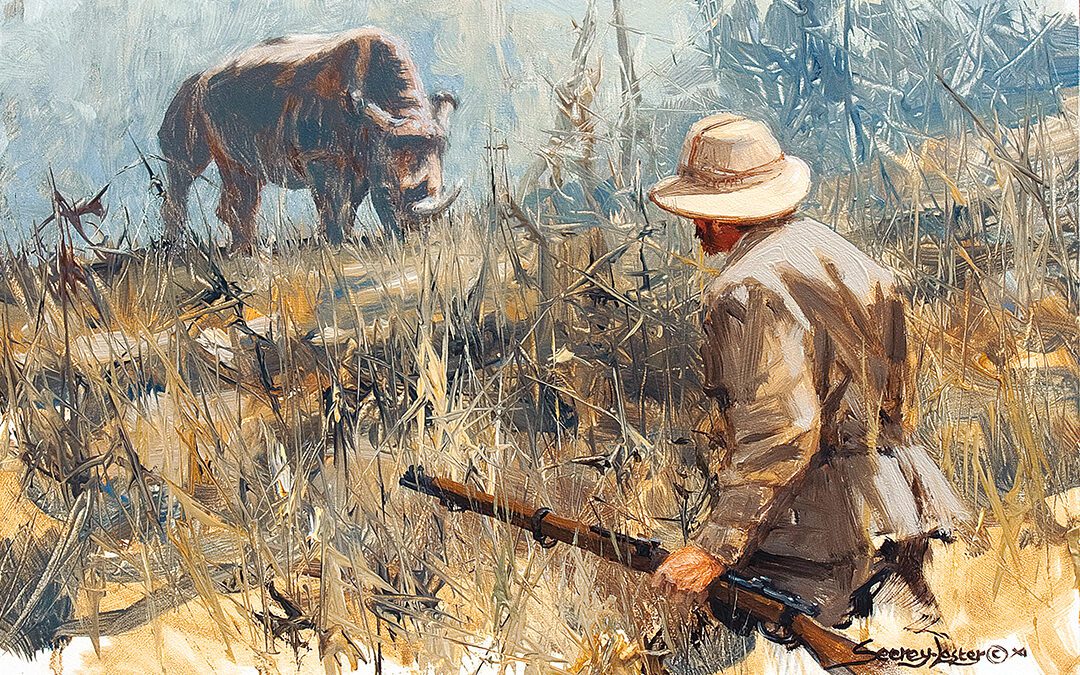The long line of native pagazi, each man carrying his allotted 60 pounds of supplies and equipment, moved like a giant mamba through acacia bushes and across the savannah. The American flag was held proudly aloft at the front of the long, seemingly endless line. Some of the natives blew on horns and whistles while others banged on tom-toms, accompanied by the occasional chanting.
The occasion was Theodore Roosevelt’s massive safari relocating from the Kapiti Plains to a new camp near Captain Slatter’s ostrich farm at the foot of Kili Makiu Mountain east of Nairobi.
When they arrived at the new camp, TR and his party hunted plains animals such as gazelles and several other kinds of antelope, and even giraffes. But they were really there to bag a black rhino.
They had just shot a bull eland some nine miles from camp when a local Wakamba man came running toward them, almost out of breath. Excitedly he told them of a big male rhino grazing on a hillside less than a mile away. He had left his companion there to watch over the animal while he brought the news to the safari.
With no time to lose, TR sent a messenger to Edmund Heller, the resident taxidermist at camp, to come out and skin the eland he had shot. TR and Capt. Slatter then rushed out to find the black rhino, with the Wakamba man leading the way.
The two men rode on horses while their gunbearers followed on foot. In less than five minutes they reached the other native who was crouched down in the grass watching the rhino. The huge bull stood boldly on an open hillside while TR and Capt. Slatter dismounted, leaving their ponies out of sight in a shallow ravine.
Crouching slightly, the hunters stalked single file toward the rhino, which seemed unaware of their approach. Luckily, he was upwind of the two men who were able to keep a small thornbush between them and their quarry. Relying on the rhino’s poor eyesight, they determined to stalk even closer.
Never taking their eyes off the rhino, they edged closer, with TR leading the way. As they neared the black monster, TR began to realize its massive bulk. The bull stood high on the brushy hillside, like a statuesque relic of prehistoric times. It was so complacent that when the men advanced to within 100 yards, the rhino simply decided to lie down. The hunters walked as lightly as possible, watching for any sudden movement by the animal.
Using a large bush as a screen, TR edged farther ahead and raised his Holland & Holland double rifle for the first time. As he stepped to one side of the bush to get a clear shot, the rhino immediately spotted him and leapt to its feet with the agility of a gazelle.
TR fired, and upon receiving the bullet the huge beast swung around and ran right at the two men. TR fired the other barrel, and though it looked to be a fatal shot, the beast somehow charged even faster.
As the ground between them quickly disappeared, Capt. Slatter moved to TR’s side and fired at the fast-approaching monster. His bullet entered the bull’s neck, but it failed to stop the onrushing beast. Intent on reaching the men, the rhino continued its charge until finally its head dropped and he plowed into the earth, its momentum bringing it to within several feet of the men.
Roosevelt was amazed at the rhino’s determination and ferocity. He considered the rhino as one of the most dangerous animals. Even when shot with the big-bore double rifle, the rhino’s sheer bulk had carried it dangerously close to the hunters.
The hunters left two of their own men with the rhino to guard it from the Wakamba during the day and lions and hyenas at night. TR and the captain, meanwhile, rode back to camp to check on Heller, and were pleased to find he had completed the job of skinning the big eland bull with the help of several Wakamba natives.
Heller said it was imperative that they return to the rhino that night so he and the native skinners could get to work as soon as possible. Moreover, he feared that the two men might not be enough to keep the bold and determined lions at bay.
By 8 p.m. the moon had risen into the starlit sky when Kermit, Heller, Capt. Slatter, and TR rode out with the skinners and with a hundred pagazi running alongside the horses. The plan was to get the work done as quickly as possible. With Kermit leading the caravan so as to maintain a fast pace, they made good time.
The long line of men went up and down the moonlit hills and watercourses with the natives chanting and whistling all the way. Before long, in the distance they could see a point of light and knew it was the fire lit by the men guarding the carcass.
When they reached the site, the pagazi quickly went to work building a thorn boma and three big fires to keep the lions away. True to Wakamba tradition, the natives squatted down and cooked strips of meat taken from the carcass as the skinners busied themselves under the direction of Heller.
TR’s fly tent, which he shared with the captain and Kermit, had been pitched about 100 yards from the dead rhino and the festivities. But it turned out to be a sleepless night as the drumming and chanting of the excited pagazi continued until morning, when the caravan, carrying the skin and leftover meat, returned to the main camp.
This story is among 60 chapters in John Seerey-Lester’s book, The Legendary Hunts of Theodore Roosevelt. The large-format, 200-page book features more than 150 paintings and sketches. Order your copy today!

